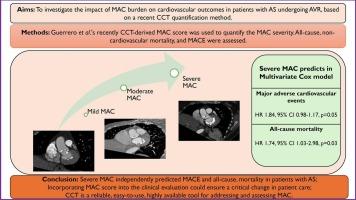主动脉瓣狭窄患者严重二尖瓣环钙化的预后意义:对主动脉瓣置换术结果的影响
IF 2.5
Q2 CARDIAC & CARDIOVASCULAR SYSTEMS
引用次数: 0
摘要
背景:二尖瓣环钙化(MAC)不再被视为仅仅与年龄有关。最近的证据表明MAC与钙化性主动脉狭窄(AS)有关,但其在接受主动脉瓣置换术(AVR)的AS患者中的预后价值尚不清楚。本研究旨在评估心脏ct衍生MAC对该人群心血管结局的影响。方法采用术前对比增强CCT,采用Guerrero CCT衍生MAC评分量化MAC严重程度。在AVR后60个月的随访期间,评估了主要不良心血管事件(MACE -心血管死亡率、显著心律失常[持续性室性心动过速、心搏停止、完全性房室传导阻滞]、中风、因心力衰竭住院)和全因死亡率和非心血管死亡率。多变量Cox模型评估重度MAC和其他重要变量的预测价值。结果共纳入313例重度AS合并AVR患者。其中34.6%的患者没有MAC的诊断标准,65.4%的患者表现为MAC(54.1%为轻度MAC, 33.6%为中度MAC, 12.1%为重度MAC)。在多变量Cox模型中,重度MAC、中度至重度二尖瓣反流和胸外科学会(STS)评分>;2.5%仍然是MACE的独立预测因子(所有p <;0.05)。此外,严重的MAC和STS分数>;2.5%仍然是全因死亡率的独立预测因子(p <;0.05)。结论本研究表明,重度MAC独立预测AVR患者预后较差,提示将其纳入临床评估可确保患者护理发生重大变化。本文章由计算机程序翻译,如有差异,请以英文原文为准。

Prognostic significance of severe mitral annular calcification in aortic stenosis: implications for aortic valve replacement outcome
Background
Mitral annulus calcification (MAC) is no longer seen as merely age-related. Recent evidence links MAC to calcific aortic stenosis (AS), but its prognostic value in AS patients undergoing aortic valve replacement (AVR) remains unclear. This study aims to assess the impact of cardiac CT-derived MAC on cardiovascular outcomes in this population.
Methods
Pre-procedural contrast-enhanced CCT was performed, and Guerrero CCT-derived MAC score was used to quantify the MAC severity. Major adverse cardiovascular events (MACE − cardiovascular mortality, significant arrhythmias [sustained ventricular tachycardia, asystole, complete atrioventricular block], stroke, hospitalizations due to heart failure) and all-cause and non-cardiovascular mortality were assessed during the 60 months of follow-up after AVR. Multivariate Cox models evaluated the predictive value of severe MAC alongside other significant variables.
Results
A total of 313 patients with severe AS and subsequent AVR were included in the study. Among these, 34.6 % of patients had no criteria for MAC, while 65.4 % exhibited MAC (54.1 % presented mild MAC, 33.6 % moderate MAC, and 12.1 % severe MAC). In multivariable Cox models, severe MAC, moderate-to-severe mitral regurgitation, and Society of Thoracic Surgeons (STS) score > 2.5 % remained independent predictors of MACE (all p < 0.05). Also, severe MAC and STS scores > 2.5 % remained independent predictors of all-cause mortality (all p < 0.05) in multivariable analysis.
Conclusion
The present study demonstrated that severe MAC independently predicted worse outcomes in patients undergoing AVR, suggesting that incorporating it into the clinical evaluation could ensure a critical change in patient care.
求助全文
通过发布文献求助,成功后即可免费获取论文全文。
去求助
来源期刊

IJC Heart and Vasculature
Medicine-Cardiology and Cardiovascular Medicine
CiteScore
4.90
自引率
10.30%
发文量
216
审稿时长
56 days
期刊介绍:
IJC Heart & Vasculature is an online-only, open-access journal dedicated to publishing original articles and reviews (also Editorials and Letters to the Editor) which report on structural and functional cardiovascular pathology, with an emphasis on imaging and disease pathophysiology. Articles must be authentic, educational, clinically relevant, and original in their content and scientific approach. IJC Heart & Vasculature requires the highest standards of scientific integrity in order to promote reliable, reproducible and verifiable research findings. All authors are advised to consult the Principles of Ethical Publishing in the International Journal of Cardiology before submitting a manuscript. Submission of a manuscript to this journal gives the publisher the right to publish that paper if it is accepted. Manuscripts may be edited to improve clarity and expression.
 求助内容:
求助内容: 应助结果提醒方式:
应助结果提醒方式:


